
|
Hidden Garden in Wilson Mountain Reservation, Dedham
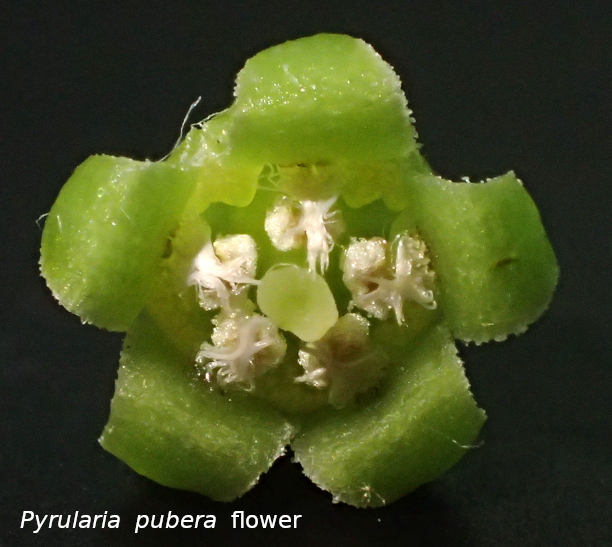
Introduction
Wilson Mountain Reservation in Dedham, MA is a nice public recreational property harboring the tallest hill in the Town of Dedham, Wilson Mountain (295 ft) and comprised of mostly hilly terrain, its steep rocky slopes blanketed with typical mixed, dryish New England forest with some wetter lowlands at hill bottoms. While wandering across this land, we were amazed to discover a rather large area in the midst of typical Massachusetts natural habitat where we found quite a few woody and herbaceous species characteristic for the southeastern US and exotic in eastern Massachusetts, some of them, apparently, naturalized and abundant. The majority of these plants have not been included in the Massachusetts County Checklist, as they have never been recorded here even as waifs, let alone naturalized members of the flora. Presented with this puzzle, we attempted to look into the history of this unusual place.
Land History
The Reservation comprises over 200 acres currently owned by the Massachusetts Department of Conservation and Recreation, the DCR, which acquired it in 1995. The neighboring property, the so-called Endicott Estate belongs to the Massachusetts Institute of Technology (MIT). As it has happened with majority of Massachusetts properties, over its long history the land has changed many hands. Back in 1880s all of it was owned by Stephen Minot Weld. Born in 1842 in Jamaica Plain, he was a descendent of Captain Joseph Weld, a prominent Puritan, who had arrived in Massachusetts Bay Colony in 1632 and owned several hundred acres in West Roxbury (which then covered an area much larger than nowadays and included much of Boston). A part of his property was later included in the Arnold Arboretum grounds.
Following the steps of his ancestor, during the 1870s, Stephen Weld acquired over a thousand acres of land from the Charles River all the way to the border of Westwood. In 1880s he built a lush summer residence in the area in Dedham we discuss. This included an elegant mansion (the building currently owned by the MIT) surrounded by a system of newly constructed interconnected small ponds, on whose shores Weld developed remarkable gardens beautifully designed and populated by some 500 species of exotic and rare plants from all over the Northern Hemisphere, including the famous "first great rock garden in North America."
A decorated army officer of the Civil War, Stephen Weld had been captivated by the nature of the southeastern states. When he started to develop his own property, keeping those vivid images in mind, he had a bold desire to recreate the beloved views of southern nature at home. An avid amateur horticulturist, Weld was influenced by his great friends Charles Sprague Sargent, the first director of the Arnold Arboretum whose tenue lasted for over 54 years, and also the Hunnewell family—another prominent name in horticulture. He found the Hunnewells to be similarly minded. Together they used to bring train car loads of rhododendrons from the Carolinas. He was then credited for inventing massive azalea plantings in North American gardens. Later, in 1907 Weld became the President of the Massachusetts Horticultural Society, which improved and flourished during the four years of his tenue. These life circumstances, friendships, and appointments made a great impact on what Weld created in Dedham. We never found a direct proof, but it seems logical to assume that most of the unusal additions to the New England woods in the Wilson Mountain Reservation must be credited to Stephen Weld and thus are about 140 years old.
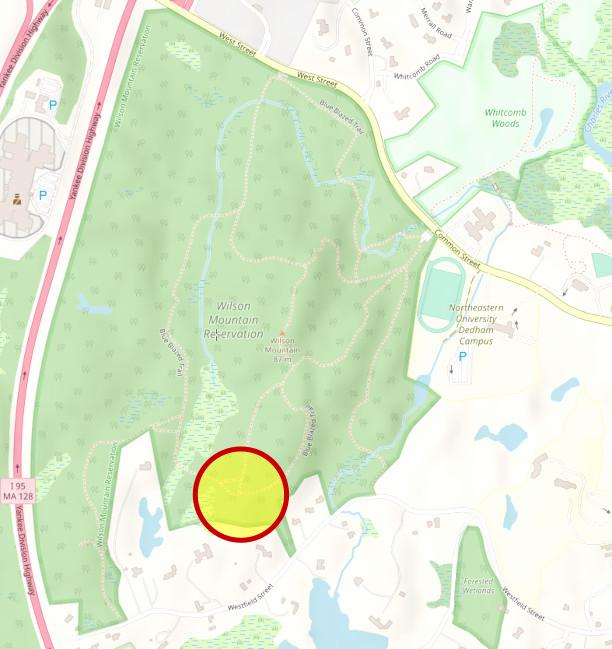 In order to connect some of remaining lose ends, we can add that Stephen Weld died in 1920. In 1926 one of his sons was forced to sell the Rockwell, as it was then called, to his mother-in-law, and she, in turn, soon sold the property to her friend from another prominent Dedham family, H. Wendell Endicott (1880-1954). H.W. Endicott maintained and further expanded the gardens. In his will, he specified that after his death part of the Rockwell, including the rock garden, would be given to a charitable organisation, either educational, scientific, or religious. Hence the MIT has been in possession of the Endicott Estate from 1955 on. The famous rock garden did not survive, but some other original Weld's and Endicott's plantings still exist. It is quite possible that Weld was not just populating his gardens, but also made a few additions to the wild habitat within his property, which was then considered a positive, beneficial move. Over one-and-a-half century, some of those introduced plants must have peacefully disappeared; others persisted and became naturalized.
In order to connect some of remaining lose ends, we can add that Stephen Weld died in 1920. In 1926 one of his sons was forced to sell the Rockwell, as it was then called, to his mother-in-law, and she, in turn, soon sold the property to her friend from another prominent Dedham family, H. Wendell Endicott (1880-1954). H.W. Endicott maintained and further expanded the gardens. In his will, he specified that after his death part of the Rockwell, including the rock garden, would be given to a charitable organisation, either educational, scientific, or religious. Hence the MIT has been in possession of the Endicott Estate from 1955 on. The famous rock garden did not survive, but some other original Weld's and Endicott's plantings still exist. It is quite possible that Weld was not just populating his gardens, but also made a few additions to the wild habitat within his property, which was then considered a positive, beneficial move. Over one-and-a-half century, some of those introduced plants must have peacefully disappeared; others persisted and became naturalized.
Our Findings
Covering an area of about 7 acres, the yellow circle drawn close to the southern border of the Reservation circumscribes an approximate center of a small area where most of the exotic plants appear to be concentrated. Nearly all these species occur within or near patches of Kalmia latifolia, which, though native to the area, must have been introduced/naturalized here as well (shown as blue contours on each map). Most of the discovered plants originate from the southeastern United States. At least half a dozen of the found exotic species appear to be naturalized; at least five could be added to the flora of Massachusetts: Buffalo nut Pyrularia pubera [FNA map]—a hemiparasitic functionally dioecious shrub from Santalaceae, redtwig doghobble or mountain fetterbush Eubotrys recurva [FNA map], American mountain andromeda Pieris floribunda [FNA map], flame azalea Rhododendron calendulaceum [FNA map], and largeflower heartleaf Hexastylis shuttleworthii [FNA map] from Aristolochiaceae. Another Hexastylis, H. arifolia [FNA map] so far has been discovered as just a single clump and therefore cannot be treated as naturalized. One more find of questionable status is a small colony (2-3 plants) of shrubby yellowroot Xanthorhiza simplicissima [FNA map]. Oconee bells Shortia galacifolia from Diapensiaceae is a recent addition as compared to other introductions. It is represented by a single planted large patch with some small outposts spreading from it onto an old forest road. Mountain winterberry holly Ilex montana is native in Berkshire County, MA, where it is protected as Threatened. This would be a new introduction for Norfolk Co., but so far there is no direct proof of naturalization. Galax urceolata and Leucothoe fontanesiana [FNA map] are already known as introduced in MA, though have not been reported from Norfolk Co. Each of Leucothoe fontanesiana patches appears to be spreading from an original planting. One more case is a solitary plant represented each year by one-two large compound leaves. Its identification remains tentative; yet most likely this is a persisting Ligusticum canadense, whose general range, despite the species epithet, is also in the southeastern United States. It could have been inadvertently introduced with one of potted shrubs transported from that region. A full list of plants of the Wilson Mountain Reservation known to us as of 2023 can be found here.
The discussed area of Wilson Mountain Reservation is nearly free from common invasives, with the only exception of a patch of lily-of-the-valley Convallaria majalis [photo] [map]). However, the adjacent area just outside the reservation border is full of invasive plants including Cardamine impatiens [photos] [map], which must constitute a new record for Norfolk County.
Wilson Mountain Reservation in Dedham, MA is a nice public recreational property harboring the tallest hill in the Town of Dedham, Wilson Mountain (295 ft) and comprised of mostly hilly terrain, its steep rocky slopes blanketed with typical mixed, dryish New England forest with some wetter lowlands at hill bottoms. While wandering across this land, we were amazed to discover a rather large area in the midst of typical Massachusetts natural habitat where we found quite a few woody and herbaceous species characteristic for the southeastern US and exotic in eastern Massachusetts, some of them, apparently, naturalized and abundant. The majority of these plants have not been included in the Massachusetts County Checklist, as they have never been recorded here even as waifs, let alone naturalized members of the flora. Presented with this puzzle, we attempted to look into the history of this unusual place.
Land History
The Reservation comprises over 200 acres currently owned by the Massachusetts Department of Conservation and Recreation, the DCR, which acquired it in 1995. The neighboring property, the so-called Endicott Estate belongs to the Massachusetts Institute of Technology (MIT). As it has happened with majority of Massachusetts properties, over its long history the land has changed many hands. Back in 1880s all of it was owned by Stephen Minot Weld. Born in 1842 in Jamaica Plain, he was a descendent of Captain Joseph Weld, a prominent Puritan, who had arrived in Massachusetts Bay Colony in 1632 and owned several hundred acres in West Roxbury (which then covered an area much larger than nowadays and included much of Boston). A part of his property was later included in the Arnold Arboretum grounds.
Following the steps of his ancestor, during the 1870s, Stephen Weld acquired over a thousand acres of land from the Charles River all the way to the border of Westwood. In 1880s he built a lush summer residence in the area in Dedham we discuss. This included an elegant mansion (the building currently owned by the MIT) surrounded by a system of newly constructed interconnected small ponds, on whose shores Weld developed remarkable gardens beautifully designed and populated by some 500 species of exotic and rare plants from all over the Northern Hemisphere, including the famous "first great rock garden in North America."
A decorated army officer of the Civil War, Stephen Weld had been captivated by the nature of the southeastern states. When he started to develop his own property, keeping those vivid images in mind, he had a bold desire to recreate the beloved views of southern nature at home. An avid amateur horticulturist, Weld was influenced by his great friends Charles Sprague Sargent, the first director of the Arnold Arboretum whose tenue lasted for over 54 years, and also the Hunnewell family—another prominent name in horticulture. He found the Hunnewells to be similarly minded. Together they used to bring train car loads of rhododendrons from the Carolinas. He was then credited for inventing massive azalea plantings in North American gardens. Later, in 1907 Weld became the President of the Massachusetts Horticultural Society, which improved and flourished during the four years of his tenue. These life circumstances, friendships, and appointments made a great impact on what Weld created in Dedham. We never found a direct proof, but it seems logical to assume that most of the unusal additions to the New England woods in the Wilson Mountain Reservation must be credited to Stephen Weld and thus are about 140 years old.
 In order to connect some of remaining lose ends, we can add that Stephen Weld died in 1920. In 1926 one of his sons was forced to sell the Rockwell, as it was then called, to his mother-in-law, and she, in turn, soon sold the property to her friend from another prominent Dedham family, H. Wendell Endicott (1880-1954). H.W. Endicott maintained and further expanded the gardens. In his will, he specified that after his death part of the Rockwell, including the rock garden, would be given to a charitable organisation, either educational, scientific, or religious. Hence the MIT has been in possession of the Endicott Estate from 1955 on. The famous rock garden did not survive, but some other original Weld's and Endicott's plantings still exist. It is quite possible that Weld was not just populating his gardens, but also made a few additions to the wild habitat within his property, which was then considered a positive, beneficial move. Over one-and-a-half century, some of those introduced plants must have peacefully disappeared; others persisted and became naturalized.
In order to connect some of remaining lose ends, we can add that Stephen Weld died in 1920. In 1926 one of his sons was forced to sell the Rockwell, as it was then called, to his mother-in-law, and she, in turn, soon sold the property to her friend from another prominent Dedham family, H. Wendell Endicott (1880-1954). H.W. Endicott maintained and further expanded the gardens. In his will, he specified that after his death part of the Rockwell, including the rock garden, would be given to a charitable organisation, either educational, scientific, or religious. Hence the MIT has been in possession of the Endicott Estate from 1955 on. The famous rock garden did not survive, but some other original Weld's and Endicott's plantings still exist. It is quite possible that Weld was not just populating his gardens, but also made a few additions to the wild habitat within his property, which was then considered a positive, beneficial move. Over one-and-a-half century, some of those introduced plants must have peacefully disappeared; others persisted and became naturalized.
Our Findings
Covering an area of about 7 acres, the yellow circle drawn close to the southern border of the Reservation circumscribes an approximate center of a small area where most of the exotic plants appear to be concentrated. Nearly all these species occur within or near patches of Kalmia latifolia, which, though native to the area, must have been introduced/naturalized here as well (shown as blue contours on each map). Most of the discovered plants originate from the southeastern United States. At least half a dozen of the found exotic species appear to be naturalized; at least five could be added to the flora of Massachusetts: Buffalo nut Pyrularia pubera [FNA map]—a hemiparasitic functionally dioecious shrub from Santalaceae, redtwig doghobble or mountain fetterbush Eubotrys recurva [FNA map], American mountain andromeda Pieris floribunda [FNA map], flame azalea Rhododendron calendulaceum [FNA map], and largeflower heartleaf Hexastylis shuttleworthii [FNA map] from Aristolochiaceae. Another Hexastylis, H. arifolia [FNA map] so far has been discovered as just a single clump and therefore cannot be treated as naturalized. One more find of questionable status is a small colony (2-3 plants) of shrubby yellowroot Xanthorhiza simplicissima [FNA map]. Oconee bells Shortia galacifolia from Diapensiaceae is a recent addition as compared to other introductions. It is represented by a single planted large patch with some small outposts spreading from it onto an old forest road. Mountain winterberry holly Ilex montana is native in Berkshire County, MA, where it is protected as Threatened. This would be a new introduction for Norfolk Co., but so far there is no direct proof of naturalization. Galax urceolata and Leucothoe fontanesiana [FNA map] are already known as introduced in MA, though have not been reported from Norfolk Co. Each of Leucothoe fontanesiana patches appears to be spreading from an original planting. One more case is a solitary plant represented each year by one-two large compound leaves. Its identification remains tentative; yet most likely this is a persisting Ligusticum canadense, whose general range, despite the species epithet, is also in the southeastern United States. It could have been inadvertently introduced with one of potted shrubs transported from that region. A full list of plants of the Wilson Mountain Reservation known to us as of 2023 can be found here.
The discussed area of Wilson Mountain Reservation is nearly free from common invasives, with the only exception of a patch of lily-of-the-valley Convallaria majalis [photo] [map]). However, the adjacent area just outside the reservation border is full of invasive plants including Cardamine impatiens [photos] [map], which must constitute a new record for Norfolk County.
Species Maps
Galax urceolata & Kalmia latifolia
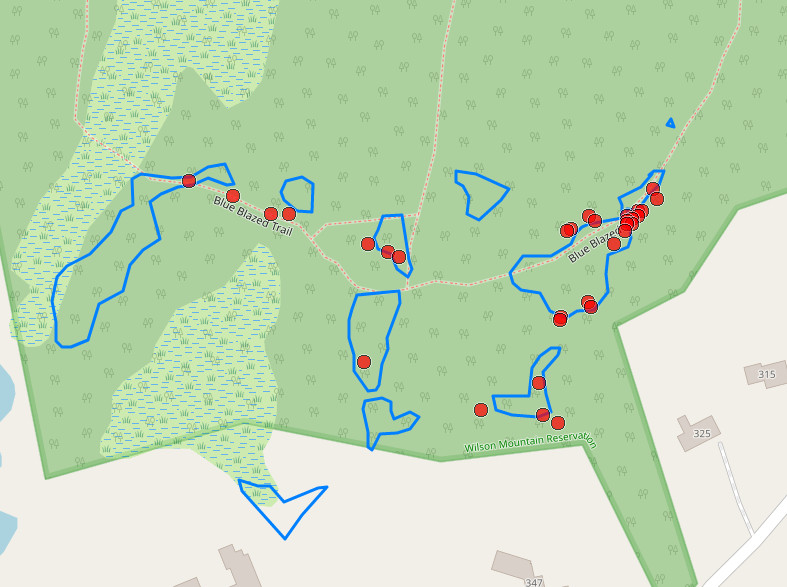
Hexastylis shuttleworthii & Kalmia latifolia
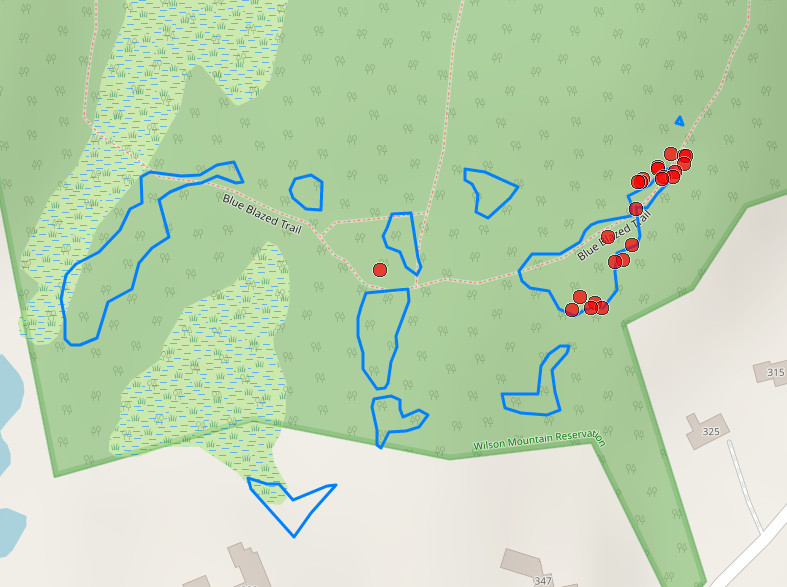
Pyrularia pubera & Kalmia latifolia
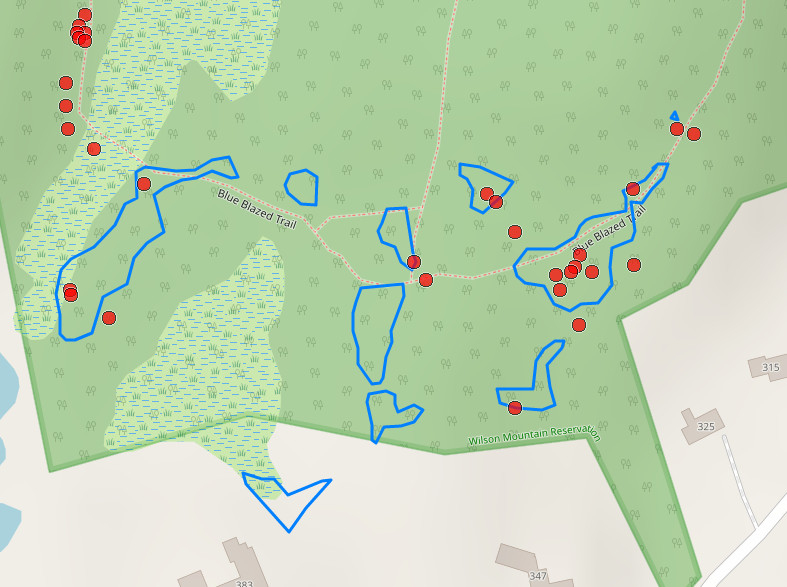
Rhododendron calendulaceum & Kalmia latifolia
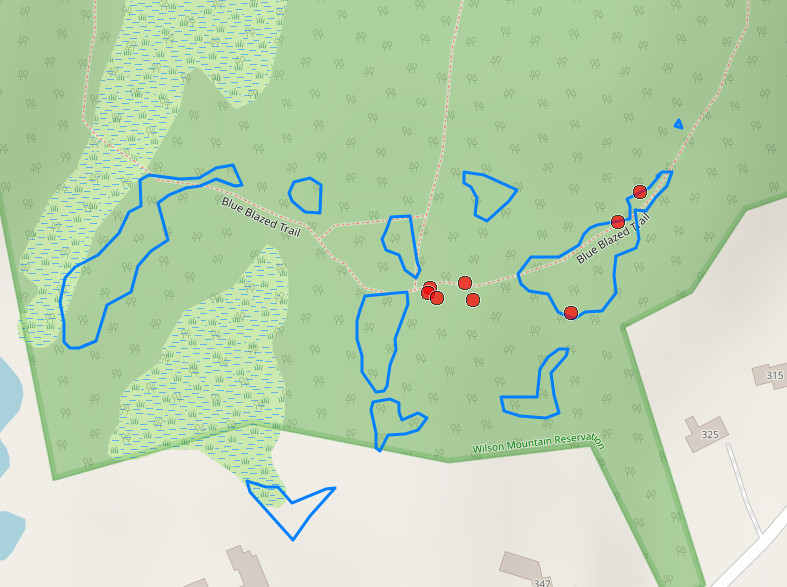
Leucothoe fontanesiana & Kalmia latifolia
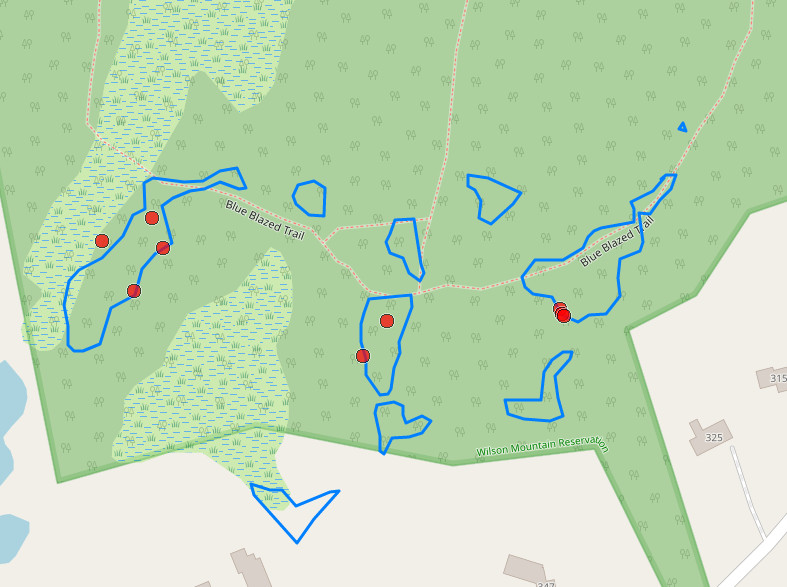
Ilex montana & Kalmia latifolia
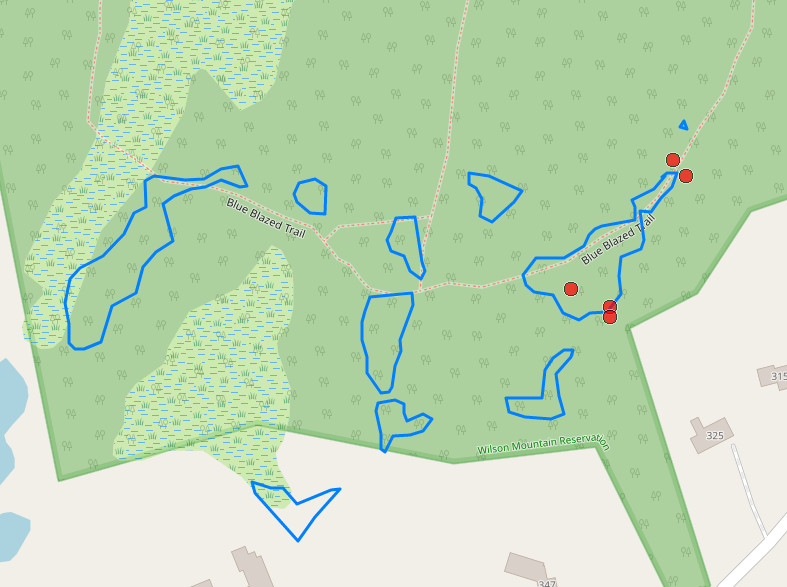
Eubotrys recurva & Kalmia latifolia
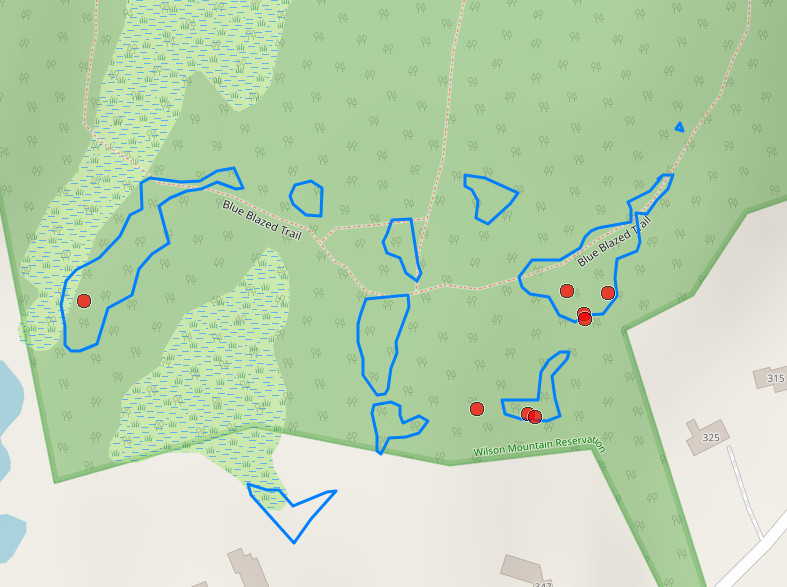
Pieris floribunda & Kalmia latifolia
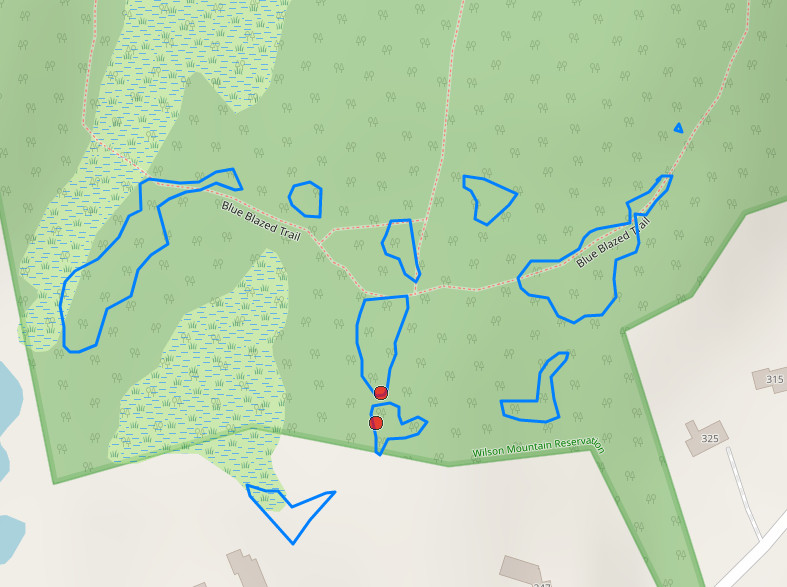
2021—2023
Last updated: 10 November 2023 |
||
| Salicicola | webmaster | |